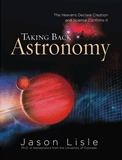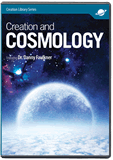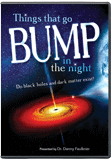
Is Bill Nye an Expert in Astronomy?
In the debate, Bill Nye did not talk much about astronomy. But when he did, he made several erroneous statements.
Millions of people from around the world watched the February 4 debate between Bill Nye and Ken Ham here at the Creation Museum. Of course, Mr. Ham is famous as the founder and president of Answers in Genesis and the Creation Museum. Mr. Nye is equally famous for being “the Science Guy” in a popular PBS children’s program in the 1990s. To many young people who grew up watching Bill Nye the Science Guy, Mr. Nye is an icon. Most of those young people, as well as many others, view Bill Nye as an expert in science, including astronomy. But is he?
Misstatements?
In the debate, Bill Nye did not talk much about astronomy. It’s just as well for him that he didn’t, because when he did speak about astronomy, he made several erroneous statements. Now, some of these errors could have been mere misstatements that everyone makes from time to time. Such misstatements are especially easy to make in a live debate in front of a large audience. An example of this is Nye’s statement that Saul Perlmutter did his work on accelerating cosmic expansion in 2004; actually, Perlmutter did his work in 1999. And Nye probably should have mentioned the similar work of Brian Schmidt and Adam Riess in 1998. These three gentlemen shared the 2011 Nobel Prize in Physics for their work. This is rather minor error and can be overlooked.
Hubble Trouble
More difficult to dismiss as a misstatement was what Nye said about Edwin Hubble’s discovery regarding the expansion of the universe. Nye stated the following:
And Edwin Hubble sat there at this very big telescope night after night studying the heavens. And he found that the stars are moving apart. The stars are moving apart. And he wasn't sure why but it was clear that the stars are moving farther and farther apart all of the time.
Hubble did not find that stars are moving apart, but rather he found that galaxies appear to be moving apart. All the individual stars that we see are in our Milky Way galaxy have their own orbital motions around the center of the Milky Way, as does the sun. As such, about half of stars are moving toward us, and about half are moving away from us. So, it is not true that even most of the stars are moving away from one another. What we are talking about is cosmic expansion, and cosmic expansion does not show up on the local level. Cosmic expansion shows up on the scale of the distances between galaxies. Ordinarily, I might be inclined to believe that this was a simple misstatement, except that Nye repeated this claim three times during the debate. Furthermore, this is a common misconception. I could not begin to count how many times people have asked me about Hubble’s work, thinking that Hubble’s discovery was that stars, rather than galaxies, are moving apart. I am inclined to give Nye the benefit of the doubt, but since this is such a common misconception, and he repeated it three times, I actually find it rather troubling.
Cosmic expansion shows up on the scale of the distances between galaxies.
Before moving on, I ought to clarify a few things about Hubble’s 1929 discovery. In the debate, Ham repeatedly introduced the distinction between observational science and interpretation of the observations. What Hubble found was a strong correlation between redshifts and distances of galaxies. That is the extent of the observational astronomy.
But what does the linear relationship between galaxy redshifts and distances mean? That is the interpretation. The most straightforward interpretation is that the universe is expanding. An expanding universe results in galaxies getting farther apart, so we usually give credit to Hubble for the discovery of the expanding universe, as Nye stated in the debate. Except that George Lemaitre had reached this conclusion in 1927, two years before Hubble. And Alexander Friedmann reached the same sort of conclusion in 1922, five years before Lemaitre did. Friedmann and Lemaitre based their conclusions upon the general solution of Einstein’s theory of general relativity applied to the universe (Einstein had chosen a specific solution), and both were probably aware of the Vesto Slipher’s pioneering 1914 paper on the redshifts of galaxies.
Observational Science Versus Interpretation
I want to emphasize that the expansion of the universe is an interpretation of the data. The observation is the linear relationship between redshifts and distances of galaxies. While the most direct interpretation is cosmic expansion, astronomers have suggested others. Even Hubble was not totally convinced that expansion was the correct interpretation. I happen to agree with the expansion interpretation, as does Answers in Genesis, evidenced by Ham’s comments during the debate where he compared expansion to biblical passages that refer to God stretching out the heavens (e.g., Job 9:8; Psalm 104:2; Isaiah 42:5).
Nye implied that the big bang model naturally follows from cosmic expansion. This is not true, for this is further interpretation, and there are other cosmological models that incorporate cosmic expansion. A notable example is the steady state theory, which for years was considered the best model. Of course, that changed in 1965 with Penzias and Wilson’s discovery of the cosmic microwave background (CMB), as Nye briefly discussed. However, Nye got some of the details wrong.
For instance, Nye said that the idea of the big bang arose a couple of decades after Hubble’s discovery of cosmic expansion. Actually, Lemaitre proposed his “cosmic egg” or “primeval atom” in his 1927 paper, two years before publication of Hubble’s work. Astronomers consider this the first suggestion of the big bang model. It’s true that Lemaitre’s proposal was a bit naïve compared to the modern theory. It’s also true that Lemaitre’s paper attracted little attention at first. However, in 1931, Sir Arthur Eddington saw to it that Lemaitre’s work received more attention (though he omitted Lemaitre’s suggestion of what became known as Hubble’s Law). Nye may have been thinking of some papers written in the late 1940s, primarily by Gamow and associates, that more closely resemble the modern big bang theory. But almost any source that discusses the history of the big bang model mentions Lemaitre’s much earlier work.
Hoyle and the Big Bang
Surprisingly bad was Nye’s suggestion that Sir Fred Hoyle had anything to do with the big bang model. During his debate presentation, Nye made this erroneous statement:
And then eventually another astronomer—almost a couple decades—another astronomer, Fred Hoyle, just remarked, “Well, it was like there was a big bang,” there was an explosion.
This would have been a surprise to Hoyle, because he was perhaps the most stalwart proponent of the steady state theory, and remained so until his death in 2001 (The steady state theory proposed that the universe is eternal and that new matter spontaneously appears to maintain constant density as the universe expands). And Hoyle was an outspoken critic of the big bang model. Nye mangled Hoyle’s quote, because Hoyle said precisely the opposite. In a 1949 BBC broadcast Hoyle commented that the universe did not begin in some big bang. Many people think that Hoyle meant the term derisively, but he later said that he used it to make it clear to his radio audience what he was criticizing. At any rate, the succinct alliteration stuck. It’s ironic that an opponent of the big bang theory is credited with naming the theory. And I am baffled as to how “the Science Guy” could make such a blatantly false statement, if he really understands the history of the big bang model.
The COBE Mission
In discussing the CMB, Nye showed a plot of the temperature curve from the COBE satellite and commented on its purpose:
We built the Cosmic Observatory for Background Emissions, the COBE Spacecraft, and it matched exactly, exactly the astronomer’s predictions.
Actually, COBE is an acronym for Cosmic Background Explorer, but that is a minor point. While the COBE project more precisely determined the temperature of the CMB, the temperature was known with reasonably good precision as far back as its 1965 discovery. However, the big bang model does not predict the temperature of the CMB, but merely the existence of the CMB. Pre-discovery predictions of the temperature had a wide range, because the model was not well constrained.
Nye appears not to grasp what the purpose of the COBE mission was, which was to detect spatial temperature fluctuations in the CMB. The big bang model predicts that there must have been irregularities in density in the early universe and that those irregularities produced slight differences in temperature in the CMB. The COBE satellite was designed specifically to detect the temperature fluctuations in the CMB predicted by the big bang theory.
The prediction was that spatial temperature fluctuations on the order of one part in 10,000 must exist in the CMB. But the COBE data showed a perfectly smooth CMB with regard to temperature. It was not until the application of a very sophisticated statistical analysis by George Smoot and his team that they were able to tweak out of the COBE data temperature fluctuations an order of magnitude lower, at one part in 100,000.
These fluctuations were at a level below the capability of the COBE mission, but they eventually were confirmed by later experiments. However, the important fact is that the data and predictions did not agree. In response to this problem, the model was altered to fit the data. Hence, to claim that the data and predictions “matched exactly” is to rewrite history.
Lord Kelvin Gaffe
At another point in the debate, Nye made a remarkable gaffe concerning Lord Kelvin:
Lord Kelvin did a calculation; if the sun was made of coal and burning, it couldn’t be more than 100,000 or so years old.
Kelvin’s calculation was actually about 30 million years based upon gravitational contraction. That’s why we call gravitational contraction as the source of the sun or any other star’s energy the Kelvin-Helmholtz mechanism. I don’t think that Kelvin ever seriously suggested coal as the sun’s source of energy, though others before him did. I suspect that Nye confused these earlier theories with Lord Kelvin.
A Questionable Comment about Parallax
Finally, in discussion of great distances in astronomy, Nye made another strange claim:
Now as far as the distance to stars, understand this is very well understood. We—it’s February. We look at a star in February, we measure an angle to it, we wait six months, we look at that same star again and we measure that angle. It’s the same way carpenters built this building. It’s the same way surveyors surveyed the land that we’re standing on. And so by measuring the distance to a star you can figure out how far away it is, that star, and then the stars beyond it and the stars beyond that. There are billions of stars, billions of stars, more than 6,000 light years from here.
What Nye briefly described here is trigonometric parallax, the only direct method of measuring stellar distances. But trigonometric parallax works only for the closest stars.
We have many indirect methods for measuring great distances that we attempt to calibrate with trigonometric parallax. There may be a hint of the other distance determination methods in Nye’s comment “and then the stars beyond it and the stars beyond that.” But in hearing what Nye actually said, one easily gets the impression that Nye thinks that trigonometric parallax works to tremendous distances. He may have just been sloppy here, but I have found that many people do not understand the limitations of trigonometric parallax. By the way, I have recently written on distance determination methods in astronomy, as well as the light travel time problem, which is what Nye was working up to here.
For more on the light travel time problem, see my articles in the Answers Research Journal, “Astronomical Distance Determination Methods and the Light Travel Time Problem” and “A Proposal for a New Solution to the Light Travel Time Problem.”
Also, there is a chapter in The New Answers Book 4 that has an overview of various proposed methods to solve the distant starlight problem.
Conclusion
As I previously stated, some of the things that I criticized here could be simple misstatements, and hence might amount to nit-picking. However, many are more difficult to explain as simple misstatements. In fact, I find the errors Bill Nye made to be remarkable and troubling.
Taking these points together, I suggest that Nye may not know nearly as much about astronomy as the general public thinks he does. The incorrect information that he presented about astronomy in the debate ought to be a bit embarrassing for the executive director of the Planetary Society, let alone “the Science Guy.”
Recommended Resources

Answers in Genesis is an apologetics ministry, dedicated to helping Christians defend their faith and proclaim the good news of Jesus Christ.
- Customer Service 800.778.3390
- © 2025 Answers in Genesis







